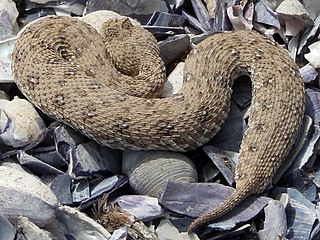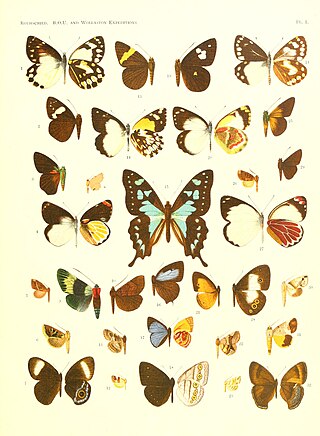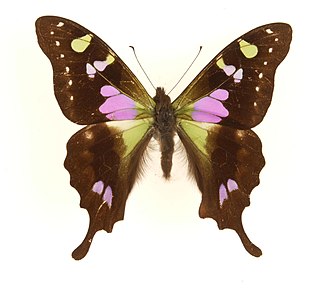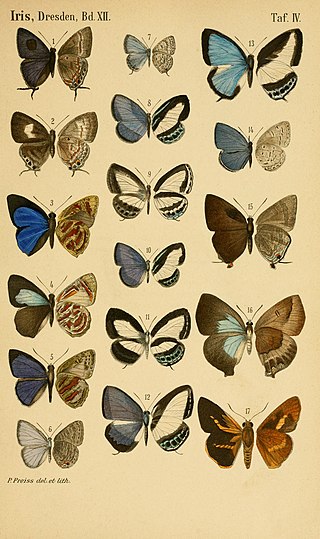
Bitis schneideri is a species of venomous snake in the subfamily Viperinae of the family Viperidae. The species is native to a small coastal region that straddles the border between Namibia and South Africa. B. schneideri is the smallest species in the genus Bitis and possibly the world's smallest viper. There are no subspecies that are currently recognized as being valid.

Nacaduba berenice, the rounded six-line blue, is a lycaenid butterfly found in Indomalayan realm. The species was first described by Gottlieb August Wilhelm Herrich-Schäffer in 1869.

Franz Josef Maria Werner was an Austrian zoologist and explorer. Specializing as a herpetologist and entomologist, Werner described numerous species and other taxa of frogs, snakes, insects, and other organisms.

Graphium stresemanni is a vulnerable species of butterfly in the family Papilionidae. It is endemic to the Indonesian island of Seram. It closely resembles the related Graphium weiskei, a more common species from New Guinea but has been treated as a distinct species. It is rare. The species was first described by Walter Rothschild in 1916.

Nacaduba is a genus of gossamer-winged butterflies (Lycaenidae). It constitutes many of the species commonly called "lineblues". As they are the genus initially erected to contain all lineblues, they might be considered the "typical" lineblues, as opposed to the species relatives now separated in Catopyrops, Petrelaea and Prosotas.

Catopyrops is a genus of butterflies in the family Lycaenidae. The range extends from India to the Malay Archipelago and the Solomon Islands.

Carl Heinrich Michael Ribbe was a German explorer and entomologist.

Graphium weiskei, the purple spotted swallowtail, is a species of butterfly in the swallowtail family; Papilionidae. It is found only in the highlands of New Guinea. These swallowtails live in elevations of 4,500 to 8,000 feet.

Nacaduba biocellata, the double-spotted line blue, is a butterfly of the family Lycaenidae. It is found in Australia, Singapore, the New Hebrides, Sumba and Bali.

Nacaduba cyanea, the tailed green-banded line-blue, is a species of butterfly in the family Lycaenidae, and formerly considered a member of the genus Danis. It is found in the Indonesia, Papua New Guinea, the Solomon Islands and Australia (Queensland).
Nacaduba ollyetti, the Woodhouse's four-line blue, is a species of Lycaenidae butterfly. It is endemic to Sri Lanka.

Arhopala pagenstecheri is a butterfly in the family Lycaenidae. It was described by Carl Ribbe in 1899. It is found in the Australasian realm where it is endemic to New Britain. The specific name honours Arnold Pagenstecher. It may be a subspecies of Arhopala florinda.

Hypochrysops pagenstecheri is a butterfly of the family Lycaenidae endemic to New Britain. The name honours Arnold Pagenstecher.

Catopyrops kokopona is a species of butterfly belonging to the lycaenid family described by Carl Ribbe in 1899. It is endemic to New Britain.

Arhopala florinda is a species of butterfly belonging to the lycaenid family described by Henley Grose-Smith in 1896. It is found in the Australasian realm where it is endemic to the Solomon Islands.

Mimene kolbei is a butterfly of the family Hesperiidae. It is endemic to New Guinea. The name honours Hermann Julius Kolbe.












